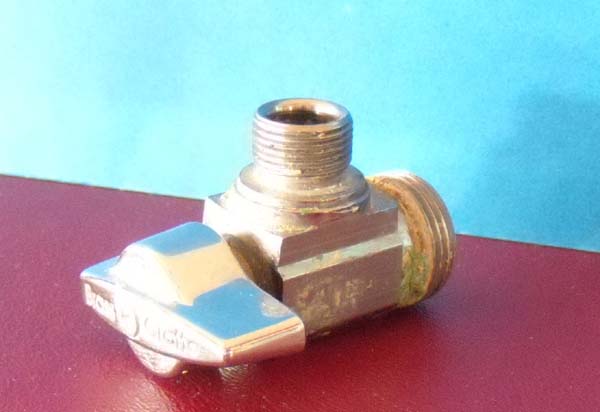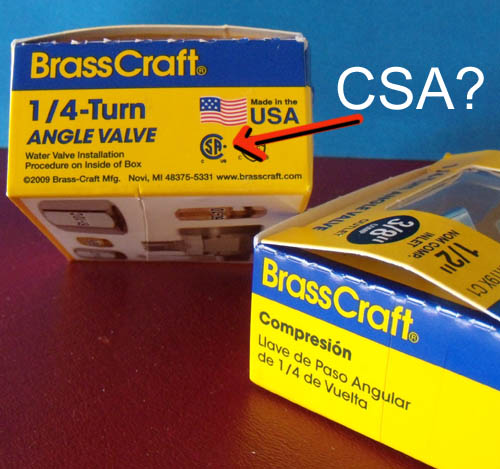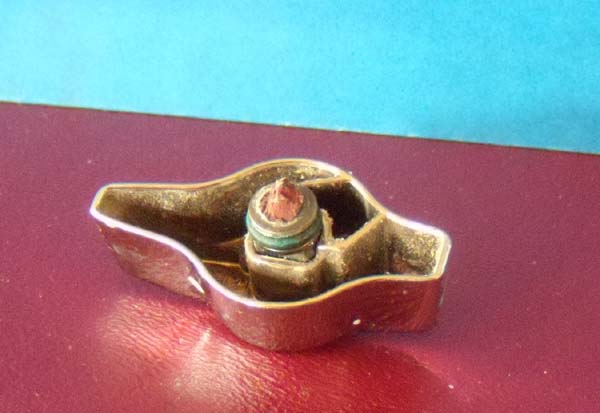Failures in the field are unacceptable. Here are some examples of products that fail to meet requirements. They end up in landfills–a waste of resources used for production, packaging, and transportation to market, and more loss to the end users who didn’t get what they expected.
Desk Lamp is Unstable
March 10, 2017
With advances in LED lighting, this TaoTronics desk lamp looked like it would fit my needs, which were:
- An adjustable (position & intensity) light to use with my “student” microscope. The ‘scope has a mirror for illuminating slides from below or with direct light from above.
- A light source for macro-photography and close-up work.
The most common complaint in the lower rated (1-3 star) reviews on Amazon cited functional failure of the light or the touch-control panel (used to vary brightness), so when I received the lamp, the first thing I did is set it up and run it through several on-off cycles, ranging from a few minutes to 24 hour on, for about 4 days. It passed this test.
But when I tried to use it for the microscope, in most positions where the lamp was not directly over the base, the whole thing would tip over. Even when standing, it didn’t take much to knock it over (note the gauge used). The video illustrates this failure mode. The lamp was returned to Amazon.
In retrospect, I did another check of the Amazon reviews, and several people mentioned this instability as a shortcoming or flat rejection. After returning the lamp, I received a couple of emails from Taotronix, referring to my poor Amazon review.
“Customer satisfaction has always been our top priority ever since we started selling on Amazon. We assign one dedicated QC team internally to strictly monitor the product quality. In spite of that, defects may still occur once a while. I truly understand that the tipping problem has been an nuisance for you and we would like a chance to make it up to you. And also we will try to fix this problem when we update our product. Many thanks to your precious advice. We can issue you a full refund or choose another model of lamp as a replacement. Please kindly let us know your preference and we will try our best to resolve your problem timely.Please remember we are always here to serve you and ensure you a happy shopping experience. SincerelySunvalleytek Customer Care
Note that they will fix the design problem later. I’m not sure what they could do to “make it up” to me—maybe send me a weight to hold it down? Previously, I returned a poorly made Taotronics TV antenna-amplifier. Taotronics Products–no more, please!
More Useless Kitchen Junk
Aug. 17, 2013
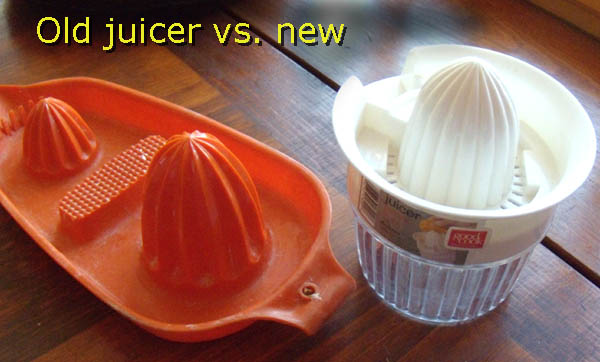
The “old” orange juicer always worked fine.
Before the days of power juicers there was the lowly juice squeezer, powered by “elbow grease”. Our old juicer was cracking up, and the hunt for a new one was not going well–none of the kitchen accessory displays seemed to have any sort of juice squeezer. Eventually, we found one. It included a resorvoir below to collect the juice and a pour spout–pretty clever. But it only took 1 orange to realize this design was seriously flawed.
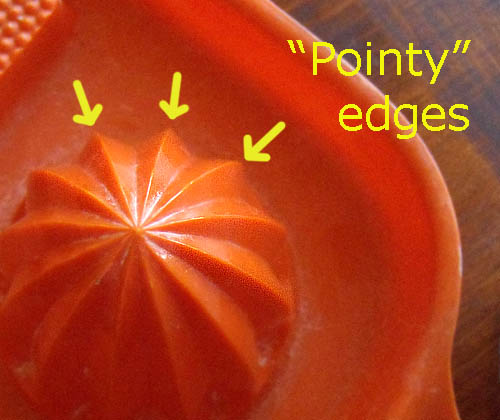
The edges give “traction” to extract juice and some pulp as the fruit is twisted back and forth.
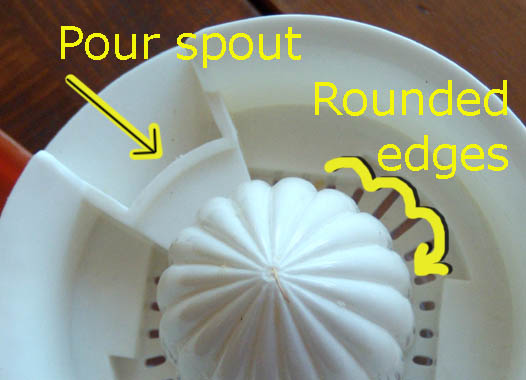
The rounded edges don’t get the job done.
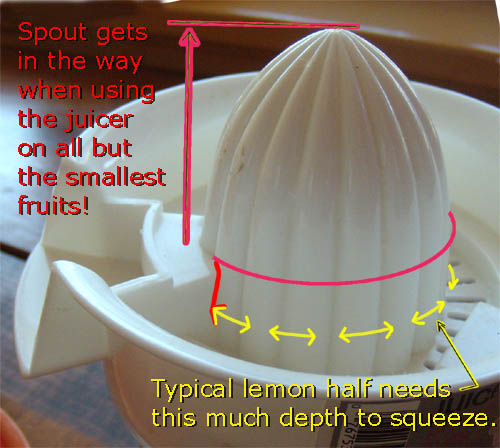
To make it more useless, the pour spout interferes with the basic squeezing operation if you use anything but the smallest fruit.
How did this reach the market? It really appears to be designed by someone who never used a manual juicer, and it was obviously not fully tested to verify it works. I believe it was designed using a CAD program, and never was evaluated at all. One more for the landfill!!
Another Bacteria Dispenser
Aug. 15, 2013
This ice cream scooper design looks like an elegant way to make it easy to pop the ice cream out of the spoon. That is, until you use it and suddenly realise that maybe the old-fashioned scoop with the button/lever gizmo is better. Watch this video to see a bad design in action!
Beverage Dispenser doubles as Bacteria Dispersion Device
July 17, 2013
This video shows how products we take for granted (they have been around for years), made in the good ole’ U.S.A. and sold by well-respected companies, sometimes fall short due to gaps in basic product development. It’s hard to believed they didn’t test this product enough to raise concerns based on food safety guidelines.
Boeing Dreamliner Battery Fires, etc.
Dreamliner Update: Cleared for Flight–Fire shuts down Heathrow!!
July 12, 2013
Per Skynews, the GOOD news:
Skynews reports that the fire does not appear to be related to the batteries.
The BAD: “A team from Britain’s Air Accidents Investigations Branch (AAIB) is looking at a number of components, including the Emergency Locator Transmitter (ELT), which is positioned in the upper rear part of the aircraft, near to the spot where the fire broke out.”
No root cause found yet–proceeding with fixes!
March 30, 2013
Boeing has stated that they have not determined the root cause of the battery fires that grounded the new 787 “Dreamliner”. Nevertheless, changes to the design and construction have been implemented and testing is underway.
Per CBS News, on March 22, 2013 (article link):
“The root cause of the battery problems isn’t known. Boeing officials said in Tokyo that it’s common for airplane flaws to be fixed even though the root cause isn’t fully understood. Executives said the improvements to the battery and its charger should reduce the chances that the problem will happen again.”
Experienced quality engineers may react to this with understanding and a bit of alarm. The pressure to ship a product is tremendous, whether it is a small gadget or an airplane. The concerns of test and quality engineers are often subject to over-riding business pressures (remember the Challenger?). Unlike the Challenger accident, there are no engineers coming forward to say they were ignored when they warned of possible safety/design issues. How could this happen? Several things come to mind:
Self Certification
The Dreamliner received FAA approval, where 90% (approx.) of the test and design data was provided by Boeing, with little government oversight or 3rd party verification, so the engineers employed by Boeing are the last line of defense against this sort of hazard. In these tough economic times, fewer people are inclined to become whistle blowers, especially when they will not receive any backing once they sound the alarm. They are often publicly characterized as disgruntled employees and are worse off than if they simply resigned in protest.
In one of the best media reports on the battery fires, The Seattle Times said (article link):
“Critics say the FAA’s heavy reliance on manufacturers to attest to the safety of their own products has largely relegated the agency to an administrative role — and has left it without the expertise and manpower to adequately challenge and revise safety standards.”
Outsourcing
The battery packs that failed were manufactured in China. There are hundreds of examples of good designs compromised (to a level where they were unsafe) when manufactured in China. To see current examples, go to the Consumer Product Safety Commission recall website (link to CPSC recalls). This is not restricted to China. All manufacturers have strong incentives to cut corners and reduce cost. A gray market or substandard component may cost less than the approved, tested piece. Without oversight, the hazardous component substitution goes unnoticed until there is a failure that causes bodily harm, death, or property damage. Without a negative incident, the manufacturer benefits from such a change, and may even reward the personnel who implemented it. The lesson here is:
You get what you INSPECT, not what you EXPECT! On-going surveillance is the best insurance against such failures. To expect manufacturers to police themselves reminds us of “the fox guarding the hen house!”
Determining Root Cause
The root cause may be defined as the condition(s) that cause the failure. You may think of it as a “switch”, where the root cause “turns on” the failure event(s). Root causes may be difficult or impossible to determine, since many such failures end in massive destruction (e.g. airliner disintegrates and crashes into the ocean). Without a demonstrable root cause, you can’t be sure that you have fixed the problem. This “educated guess” may be correct, but it is absent the logic and assurances of finding the root cause. This video shows Boeing’s attempt to prevent battery fires (at 0:50 in the clip).
[youtube http://www.youtube.com/watch?v=Qw-cGAtIXeQ]This solution makes sense, but only time will tell if it is effective. If the root cause is something else, such as corner-cutting in manufacturing the lithium ion cells, we can expect more trouble. Certainly the fire will be less likely to spread, but who wants to fly on a plane where anything catches fire!
Cell Phone Headset
March 20, 2013
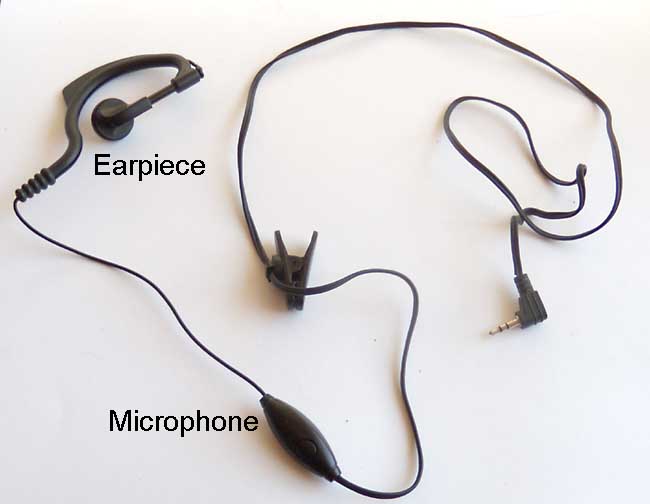 To comply with the California law on driving while talking on a cellphone, I purchased a couple of inexpensive earphone/microphone “hands free” headsets. One failed within a day. No big deal–these were CHEAP. The other headset worked for a couple of months, but ended up in the junk box when I got a new phone. The mini-plug is slightly smaller than a conventional 2.5 mm jack, and I was going to see if I could re-use the plug on my GoPro camera.
To comply with the California law on driving while talking on a cellphone, I purchased a couple of inexpensive earphone/microphone “hands free” headsets. One failed within a day. No big deal–these were CHEAP. The other headset worked for a couple of months, but ended up in the junk box when I got a new phone. The mini-plug is slightly smaller than a conventional 2.5 mm jack, and I was going to see if I could re-use the plug on my GoPro camera.
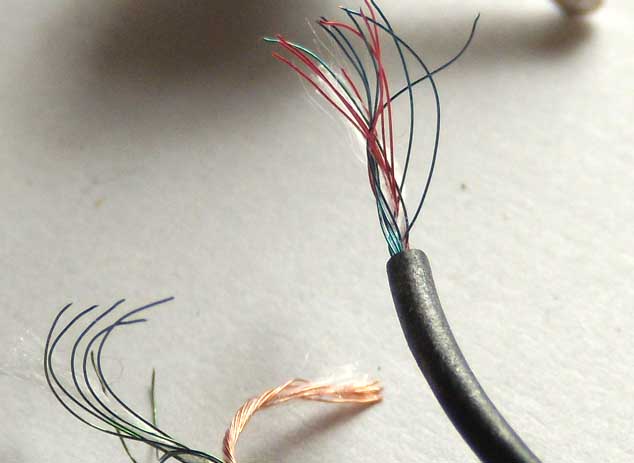 The first step was to identify (ohm out) the conductors to the plug. After stripping the 2 wires, I expected to find a classic center conductor and shielding. Instead, the wires were just strands of enameled wire (1 pair green & red, 2nd pair green and copper) with some nylon string!
The first step was to identify (ohm out) the conductors to the plug. After stripping the 2 wires, I expected to find a classic center conductor and shielding. Instead, the wires were just strands of enameled wire (1 pair green & red, 2nd pair green and copper) with some nylon string!
Forget about re-use. This was the first time I’ve seen enamel insulation used in a cable that will be flexed, folded, and moved frequently. Any flaws in the enamel would eventually cause a short when flexed repeatedly.
Lesson: “You get what you pay for,” or maybe it would be better to say “you don’t get what you don’t pay for!”
Precision Meat Thermometer?
Dec. 10, 2012
For the best results when cooking thicker cuts of meat, experts recommend using a meat thermometer to ensure the food is safe, yet not over-cooked. This one was purchased at a local grocery store, but I noticed a problem when I was removing it from the packaging.
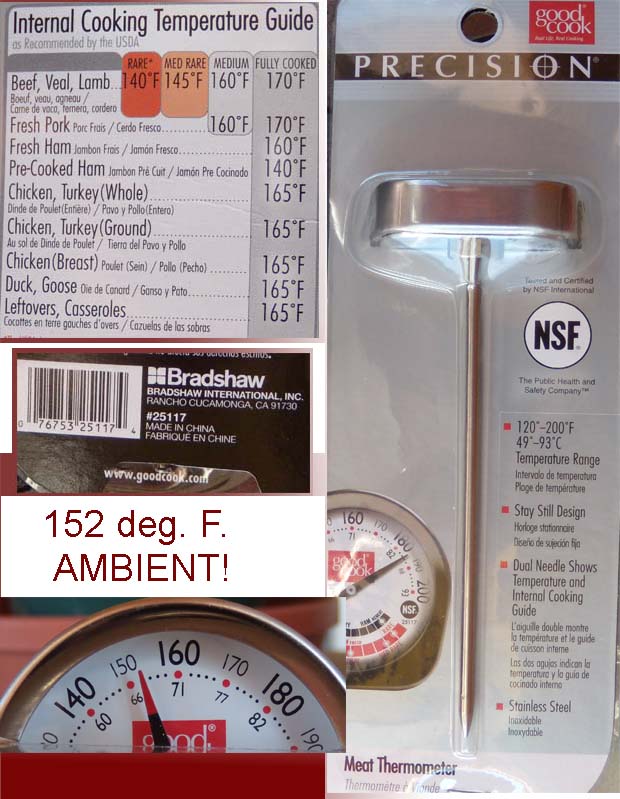 With a room temperature of 70°F., the meat thermometer was reading 152°F–just 8 degrees below the recommended fully cooked temperature for several cuts of meat. This unit was returned. After looking at approx. 20 more samples in 3 stores, NONE were free of this flaw–all had ambient readings near 160°F. One clerk suggested there was a way to adjust this reading, but there was nothing in the instructions or markings to suggest this was true.
With a room temperature of 70°F., the meat thermometer was reading 152°F–just 8 degrees below the recommended fully cooked temperature for several cuts of meat. This unit was returned. After looking at approx. 20 more samples in 3 stores, NONE were free of this flaw–all had ambient readings near 160°F. One clerk suggested there was a way to adjust this reading, but there was nothing in the instructions or markings to suggest this was true.
The label says “Tested and certified by NSF International” next to the large NSF symbol. The NSF website lists this product (use “Search Listings”) as tested to “NSF ANSI 2-2009 Food Equipment“. The standard seems reasonable.
Per clause 5.45.4: Unless otherwise specified by this section, temperature-indicating devices shall have an accuracy of ± 2 °F (± 1 °C) at critical temperatures within the range of the device.
Per clause 6.33: Each of the three thermometers tested shall be accurate when compared to the reading of the calibrated thermometer. Unless otherwise specified below, thermometers shall be tested for an accuracy of ± 2 °F (±1 °C) at critical temperatures throughout the use range. Critical test temperatures are as follows: 0 °F(-18 °C), 40 °F (4 °C), 145 °F(63°C), and 170 °F (77 °C).
The BIG QUESTION: How did this product pass tests at the critical temperatures?
ANSWER: The 3 samples submitted to the lab passed, but production tests are deficient or not done. This is disturbing, since the thermometer is a key tool in ensuring food safety.
Water Shutoff Valve
July 12, 2012
This Brasscraft 1/4 turn shutoff valve was installed in a 2004 or 2009, as part of kitchen sink plumbing “upgrades” and remodeling. In July, 2012, we needed to replace the faucet. When this valve was turned off, the valve handle snapped off under a little finger pressure. To make matters worse, it started dripping hot water (est. 1 litre/hr.). The photo below shows the cracked shaft.
The metal shaft totally gave way. An O-ring came off with the shaft, allowing the valve to drip, even in the off position. The water for the home had to be shut off while repairs were made. Sadly, the replacement part was identical. The “plumbing department guy” at Home Depot said this failure was pretty common. They didn’t have a higher grade part.
Root Cause Analysis
The metal in the shaft gave way in less than 8 years, perhaps due to some sort of corrosion from chemicals in the hot water supply or substandard/gray market materials. This lack of durability in a part that is CSA certified was surprising. The manufacturer will be contacted to further understand this failure and the cause.
The big question:
If the valves won’t last 8 years, how often do I have to tear apart my plumbing to replace these, as part of preventive maintenance?
UPDATE: My plumber advised that it was useful to cycle these valves off / on every few months to prevent mineral buildup in the valve mechanism.

